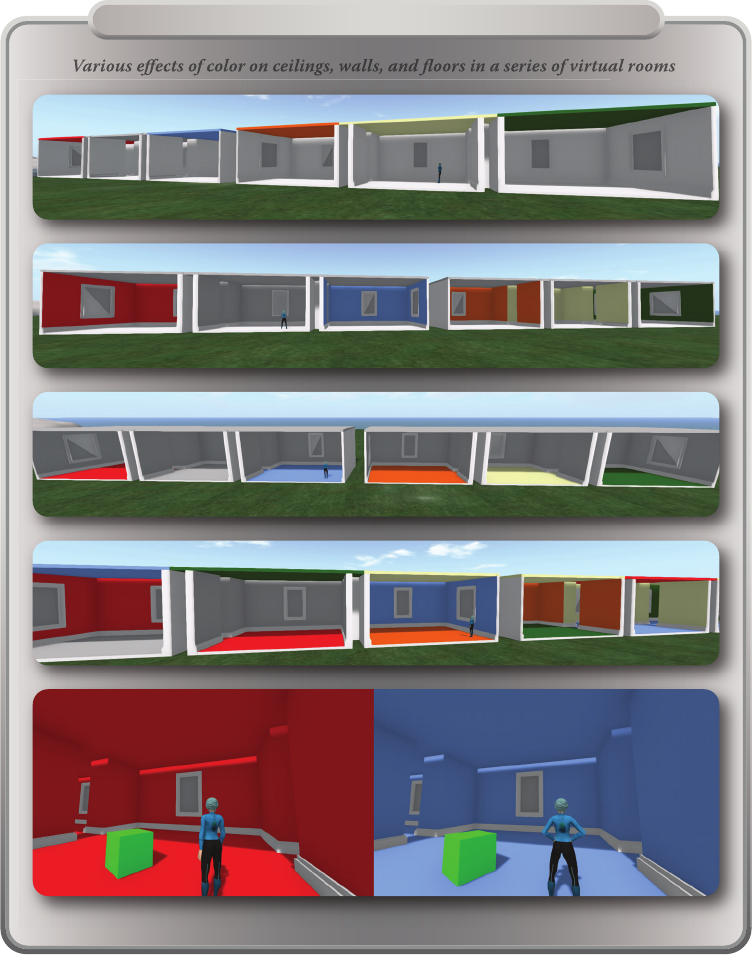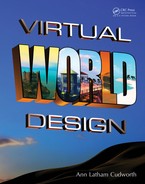
Color by Decade: 1950 - 2000
1960s
soft warm colors
bold psychedelics
1st James Bond movie / 1st Dr. Who episode / Peter Max / Star Trek on TV
1970s
strong, warm
earth tones
M*A*S*H* TV show / Star Wars movie / "Roots" miniseries / VCRs available
1980s
lighter softer colors,
sophisticated style palette
Pac-Man / Rubik's Cube / CNN / PCs from IBM / Miami Vice TV show
1990s
bolder deeper
new digital color
Hubble Telescope / Internet / Hale-Bopp comet / Pathfinder on Mars
2000s
lighter, realistic
digital color
Wikipedia / YouTube / Smartphones / Tablets / Google Street view / Facebook
1950s
softer, warmer colors
Color TV / DNA discovered / Disneyland opens / Elvis / "The Cat in the Hat" / LEGO toy bricks
FIGURE 7.3 Chart of color palettes by decade (1950–2010) based on color samplings from pop cultural images from
these times.

Effects of Color in the Environment
FIGURE 7.4 Screen grabs from OpenSim showing the effect of color changes on the ceilings, walls, and oors of
interconnected rooms (top four images). In the bottom two images, the effect of a warm color on the perception of the
virtual space is contrasted with that of a cool color.

Enhancement of Flow and Energy with Color Space Design
Traffic Pattern Analysis and
Color Progression Planning
in a Virtual Conference Center
Beginning of day traffic flow
Lunch break traffic flow
Morning session traffic flow
End of day traffic flow
Cool, but not cold colors
to stimulate relaxation
and intellectual thought
Cool, but not cold colors
to stimulate relaxation
and intellectual thought
Warm colors to encourage
centrifugal movement
and conversation
Varied but balanced palette
to keep them stimulated
but not distracted
Warm colors to wake
them up and keep
them moving
FIGURE 7.5 Chart showing a conference environment, and how the spatial circulation and interactivity during the
event could be analyzed and inuenced with a color space design.

Color Temperature of Light - Effects on Scene
6 am 6 pm
9 am 3 pm
12 pm
Recreation of “Barry Lyndon” scene - shooting
in “candle light.” Shot on location at Academie
Royale des Sciences, Languedoc Coeur, Second Life
Recreation of “Eyes Wide Shut” scene showing
large range of color temperature. Shot on location
in Bay City - Moloch, Second Life
Color Temperature changes in
the arc of a day and affects
the appearance of other
colors in the scene
Candle light
1500K
2000-3000K
Sunrise
5,500K
10,000K
Midday Clear Sky
Color Temperature
measured in
degrees Kelvin (K)
5,500K
2000-3000K
Sunset
Candle light
1500K
FIGURE 8.1 Chart showing how the color temperature of virtual light effects the look of a virtual environment. These
frame grabs from Second Life show how the color temperature of virtual light changes throughout the day cycle. These
observations can be compared to the physical world color temperature scale in the middle. In the lower section, two
scenes from Stanley Kubrick’s lms “Barry Lyndon” and “Eyes Wide Shut” have been re-created to display how color
temperature in a virtual scene can be manipulated for machinima just as it was for these lms.

FIGURE 8.6 Screen shots showing lighting for a night scene inside a large indoor environment. Top left image shows
the WindLight setting for Lunar Morning 7. Top right image shows positioning the background (ll) light on the left side
and the front (key) light on the right side. In the bottom image, the lines point toward the targets of these lights.
..................Content has been hidden....................
You can't read the all page of ebook, please click here login for view all page.
